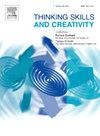Can creative musical and mathematical thinking be developed among first and second graders?
IF 4.5
2区 教育学
Q1 Social Sciences
引用次数: 0
Abstract
Background
Multidisciplinary education and creative thinking are significant components of 21st-century skills. However, limited research exists on the impact of multidisciplinary STEAM initiatives on creativity in primary schools, particularly in the first and second grades.
Aims
This study investigates the development of creative thinking in math and music among first- and second-grade students through an integrated study program.
Sample
The study involved 206 students.
Methods
Four classes (two first-grade and second-grade classes) participated in the intervention group (MusiMath, n = 106) and four peer classes served as a control group (n = 100). All students received 3 MusiMath lessons and were assessed for baseline; the intervention groups had an additional 7 MusiMath lessons, and all students were assessed at lessons 6 and 9. The MusiMath program integrates music and mathematics with a focus on creative thinking. All students engaged in open-ended tasks linking musical properties to mathematical patterns and symmetry, which were analyzed for fluency, flexibility, and originality.
Results
The study’s three assessments revealed that students in the intervention group demonstrated a significant increase in flexibility in their musical creative thinking, although originality declined over time in both groups, possibly due to increased familiarity with the creativity tasks. In mathematics, second graders in the intervention group showed the most notable gains in both fluency and flexibility. While their level of originality remained stable, the control group exhibited a consistent decline in originality across timepoints.
Conclusions
The study demonstrates the possibility of employing a multidisciplinary approach to develop creative thinking within both subject areas of the elementary school curriculum.
创造性的音乐思维和数学思维能在一二年级学生中得到发展吗?
多学科教育和创造性思维是21世纪技能的重要组成部分。然而,关于多学科STEAM计划对小学创造力的影响的研究有限,特别是在一年级和二年级。目的本研究以一、二年级学生为研究对象,探讨其在数学与音乐方面的创造性思维发展。这项研究涉及206名学生。方法干预组(MusiMath, 1年级和2年级)共4个班级(n = 106),对照组(n = 100)为同龄班级(4个班级)。所有学生接受3节MusiMath课程并进行基线评估;干预组有额外的7节数学课,所有学生都在第6课和第9课进行评估。MusiMath课程将音乐和数学结合起来,重点是创造性思维。所有学生都参与了将音乐属性与数学模式和对称性联系起来的开放式任务,并对其流畅性、灵活性和独创性进行了分析。研究的三个评估结果显示,干预组的学生在音乐创造性思维方面表现出了显著的灵活性,尽管随着时间的推移,两组学生的独创性都有所下降,这可能是由于对创造性任务的熟悉程度增加。在数学方面,干预组的二年级学生在流畅性和灵活性方面都表现出最显著的进步。虽然他们的独创性水平保持稳定,但对照组的独创性在各个时间点上都表现出持续的下降。结论:本研究证明了在小学课程的两个学科领域中采用多学科方法培养创造性思维的可能性。
本文章由计算机程序翻译,如有差异,请以英文原文为准。
求助全文
约1分钟内获得全文
求助全文
来源期刊

Thinking Skills and Creativity
EDUCATION & EDUCATIONAL RESEARCH-
CiteScore
6.40
自引率
16.20%
发文量
172
审稿时长
76 days
期刊介绍:
Thinking Skills and Creativity is a new journal providing a peer-reviewed forum for communication and debate for the community of researchers interested in teaching for thinking and creativity. Papers may represent a variety of theoretical perspectives and methodological approaches and may relate to any age level in a diversity of settings: formal and informal, education and work-based.
 求助内容:
求助内容: 应助结果提醒方式:
应助结果提醒方式:


